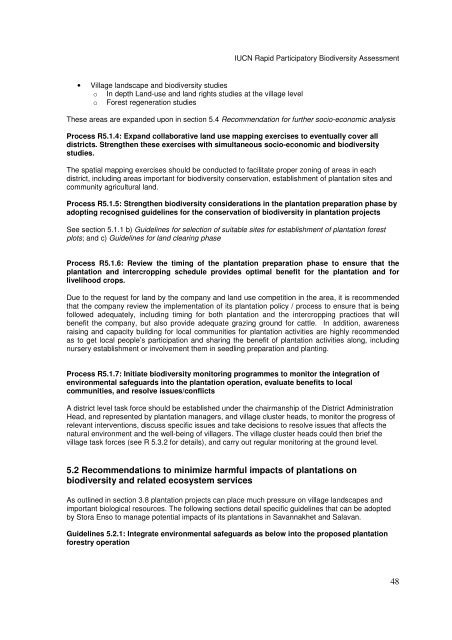Part 1 – A Rapid Participatory Biodiversity Assessment - IUCN
Part 1 – A Rapid Participatory Biodiversity Assessment - IUCN
Part 1 – A Rapid Participatory Biodiversity Assessment - IUCN
You also want an ePaper? Increase the reach of your titles
YUMPU automatically turns print PDFs into web optimized ePapers that Google loves.
• Village landscape and biodiversity studies<br />
o In depth Land-use and land rights studies at the village level<br />
o Forest regeneration studies<br />
<strong>IUCN</strong> <strong>Rapid</strong> <strong>Part</strong>icipatory <strong>Biodiversity</strong> <strong>Assessment</strong><br />
These areas are expanded upon in section 5.4 Recommendation for further socio-economic analysis<br />
Process R5.1.4: Expand collaborative land use mapping exercises to eventually cover all<br />
districts. Strengthen these exercises with simultaneous socio-economic and biodiversity<br />
studies.<br />
The spatial mapping exercises should be conducted to facilitate proper zoning of areas in each<br />
district, including areas important for biodiversity conservation, establishment of plantation sites and<br />
community agricultural land.<br />
Process R5.1.5: Strengthen biodiversity considerations in the plantation preparation phase by<br />
adopting recognised guidelines for the conservation of biodiversity in plantation projects<br />
See section 5.1.1 b) Guidelines for selection of suitable sites for establishment of plantation forest<br />
plots; and c) Guidelines for land clearing phase<br />
Process R5.1.6: Review the timing of the plantation preparation phase to ensure that the<br />
plantation and intercropping schedule provides optimal benefit for the plantation and for<br />
livelihood crops.<br />
Due to the request for land by the company and land use competition in the area, it is recommended<br />
that the company review the implementation of its plantation policy / process to ensure that is being<br />
followed adequately, including timing for both plantation and the intercropping practices that will<br />
benefit the company, but also provide adequate grazing ground for cattle. In addition, awareness<br />
raising and capacity building for local communities for plantation activities are highly recommended<br />
as to get local people’s participation and sharing the benefit of plantation activities along, including<br />
nursery establishment or involvement them in seedling preparation and planting.<br />
Process R5.1.7: Initiate biodiversity monitoring programmes to monitor the integration of<br />
environmental safeguards into the plantation operation, evaluate benefits to local<br />
communities, and resolve issues/conflicts<br />
A district level task force should be established under the chairmanship of the District Administration<br />
Head, and represented by plantation managers, and village cluster heads, to monitor the progress of<br />
relevant interventions, discuss specific issues and take decisions to resolve issues that affects the<br />
natural environment and the well-being of villagers. The village cluster heads could then brief the<br />
village task forces (see R 5.3.2 for details), and carry out regular monitoring at the ground level.<br />
5.2 Recommendations to minimize harmful impacts of plantations on<br />
biodiversity and related ecosystem services<br />
As outlined in section 3.8 plantation projects can place much pressure on village landscapes and<br />
important biological resources. The following sections detail specific guidelines that can be adopted<br />
by Stora Enso to manage potential impacts of its plantations in Savannakhet and Salavan.<br />
Guidelines 5.2.1: Integrate environmental safeguards as below into the proposed plantation<br />
forestry operation<br />
48

















